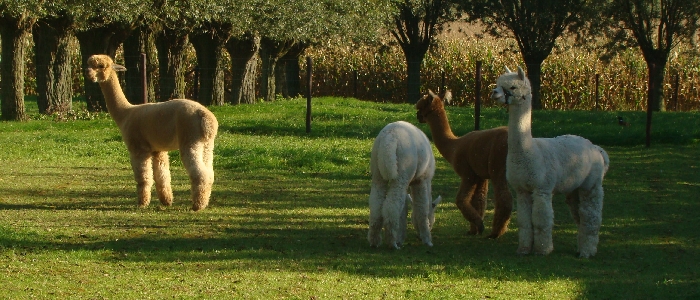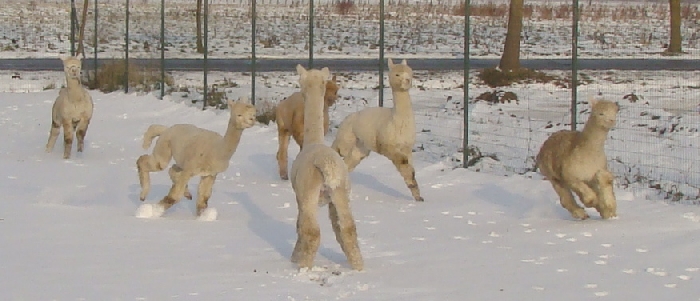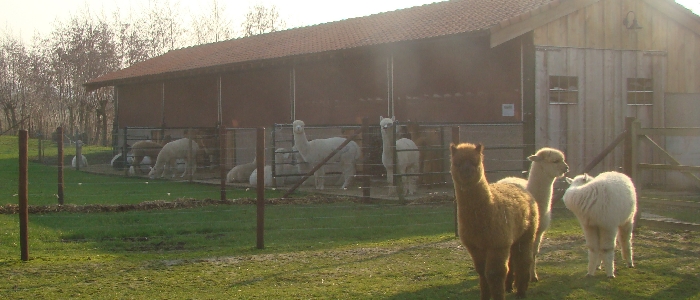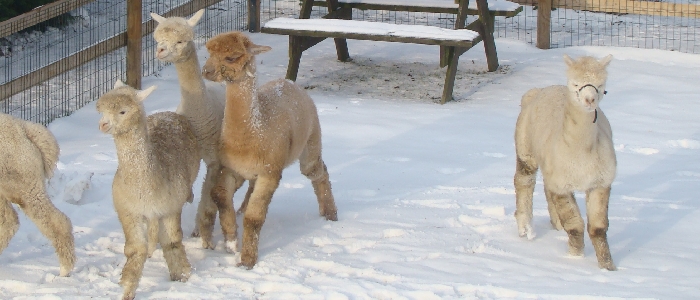Kweken voor grijs
BREEDING FOR GREY
By Nic Cooper, Southern Alpacas Stud
The grey alpaca is an attractive goal for many breeders, but also an elusive one. Concentrate on breeding greys, and you will get at least 50% of other colours. You may also get a few blue eyed deaf whites along the way.
Grey genetics is a complex subject which has been well studied and documented by Elizabeth Paul in Australia, and by Andrew and Ann Merriwether in USA.
Grey is not a straight basic mendelian relationship. Grey is thought to come about through the combination of a Merle allele, and white spotting allele. Merle genes in other species have intermediate expression. It can appear in a range of different intensities.
Merle genes are also linked closely to deafness, blindness, sterility and in extreme forms death. It is probably that at least some of these traits are linked to grey alpacas.
The incidence of blue eyed whites (deaf) is clearly linked to greys and white spots.
We at Southern Alpacas Stud have noted a greater pregnancy slippage (and revisit for remate) when using our grey males, particularly over grey females.
The two instances of undeveloped ovaries we have encountered have both been in greys.
Read Paul or Merriwether for more detailed genetic analysis.
But it is clear that if greys are to continue to be a sought after part of the alpaca herd (and they certainly have a place, a rarity, and a demand), there needs to be more emphasis placed on the way greys are "produced" by breeders.
Practical Considerations
The practical conclusions of recent genetic research means adopting a very specific breeding regime, if you want to breed grey alpacas, and maximise both pregnancy success, and grey offspring.
Grey-grey mating does not maximise those goals, as it is now known that grey-grey mating carries a fatal gene, and therefore a higher incidence of pregnancy slippage and possibly sterility.
Summarising (and simplifying) the research:
? Grey carries a fatal gene (creating higher foetal re-absorption, and incidence of re-mate).
? Background grey in past generations does not necessarily enhance chances of grey offspring (the merle gene is not a recessive gene, it is an incomplete dominant).
? Grey-on-grey matings give 50% grey live offspring.
? Grey-on-absolutely solid colour matings give 50% grey live offspring.
? Grey and the white spot gene combine to give blue eyed whites (that are deaf).
So the learnings for mating goals with greys, to produce more grey offspring are:
? Grey on grey reduces the chance of live birth success.
? Grey on solid black, or grey on solid brown/fawn gives the same birthing chance for grey (silver or roan).
? Use grey males over solid coloured females.
? Use solid coloured males over grey females.
? Make absolutely sure the "solid coloured" alpaca has not a speck of white on it i.e. no white spot gene.
? Remember that a "solid" white alpaca may well be masking a white spot gene. You just cannot see it.
? If you mate a grey and an alpaca with any white on it - including solid whites - you risk a blue eyed white.
And if you happen to have a blue eyed white to breed from, using a solid, coloured (not white) male enhances your chance of a grey offspring.
[2009-02-23 door Nic Cooper]







